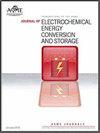N,N-二乙基乙醇氯化铵/乙二醇基DES替代离子液体的理化性质
IF 1.9
4区 工程技术
Q3 ELECTROCHEMISTRY
Journal of Electrochemical Energy Conversion and Storage
Pub Date : 2023-01-10
DOI:10.1115/1.4056638
引用次数: 0
摘要
与深度共晶溶剂(DES)相比,目前市场上使用的离子液体(ILs)具有加工复杂、高粘度和高毒性的特点。深共晶溶剂通常用于热能储存、分离萃取过程或电化学领域。本研究的重点是确定DES的物理化学性质,即热导率,粘度和表面张力。以不同摩尔组成的氢键给体(HBD)化合物(乙二醇)和氢键受体(HBA)化合物(N,N-二乙基乙醇氯化铵)混合制备了深度共晶溶剂。结果表明,当HBA:HBD的摩尔比为1:2时,最佳导热系数为0.218 W/mK,低粘度为38.1 cP,高表面张力为54 mN/m。最值得注意的是,DES能够在环境条件下(25°C)在液相中维持30天以上。FTIR光谱未显示任何新峰的存在。这证实了离子只发生离域,因此在混合过程中不会发生化学转化。实验结果表明,新合成的溶剂(DES)具有较好的效果。因此,可以提出使用DES来取代对ILs的依赖。本文章由计算机程序翻译,如有差异,请以英文原文为准。
Physicochemical Properties of N,N-Diethylethanolammonium Chloride/Ethylene Glycol based DES for Replacement of Ionic Liquid
Ionic Liquids (ILs) that are used in the market nowadays have high complexity of processing, high viscosity and high toxicity in comparison to deep eutectic solvent (DES). Deep eutectic solvent is typically used in thermal energy storage, separation and extraction process or electrochemistry field. This study focuses on determining the physicochemical properties of DES, which are thermal conductivity, viscosity, and surface tension. Deep Eutectic Solvent was prepared by mixing hydrogen bond donor (HBD) compounds (ethylene glycol) and hydrogen bond acceptor (HBA) compounds (N,N-Diethylethanolammonium chloride) at different molar compositions. The data shows that the molar ratio HBA:HBD of 1:2 resulted in optimized values of thermal conductivity (0.218 W/mK), low viscosity (38.1 cP) and high surface tension (54 mN/m). Most notably, DES is capable of sustaining in a liquid phase at ambient condition (25°C) for more than 30 days. FTIR spectrum did not indicate any presence of a new peak. This established that only delocalization of ions occurred, and hence chemical transformations did not take place during mixing. The data obtained showed that the new synthesized solvent (DES) possess better result than the ILs. Therefore, DES can be proposed to replace the dependency to ILs.
求助全文
通过发布文献求助,成功后即可免费获取论文全文。
去求助
来源期刊

Journal of Electrochemical Energy Conversion and Storage
Engineering-Mechanics of Materials
CiteScore
4.90
自引率
4.00%
发文量
69
期刊介绍:
The Journal of Electrochemical Energy Conversion and Storage focuses on processes, components, devices and systems that store and convert electrical and chemical energy. This journal publishes peer-reviewed archival scholarly articles, research papers, technical briefs, review articles, perspective articles, and special volumes. Specific areas of interest include electrochemical engineering, electrocatalysis, novel materials, analysis and design of components, devices, and systems, balance of plant, novel numerical and analytical simulations, advanced materials characterization, innovative material synthesis and manufacturing methods, thermal management, reliability, durability, and damage tolerance.
 求助内容:
求助内容: 应助结果提醒方式:
应助结果提醒方式:


